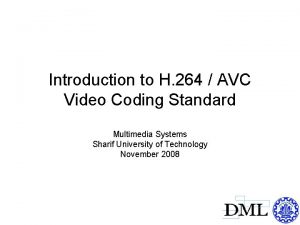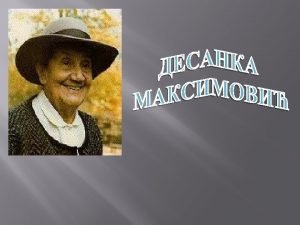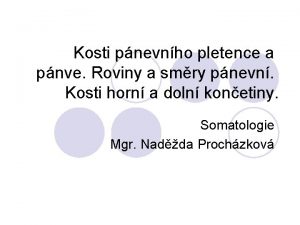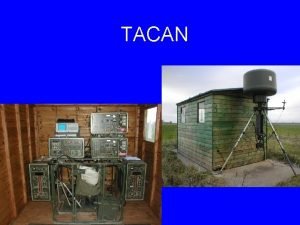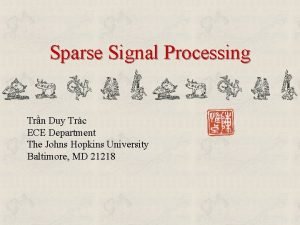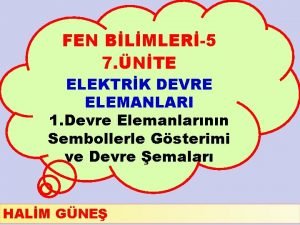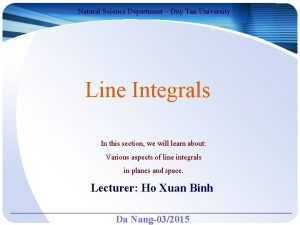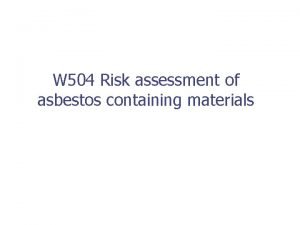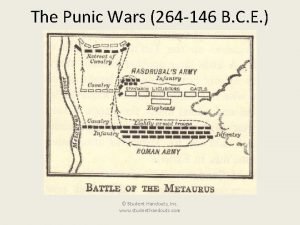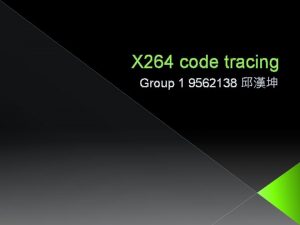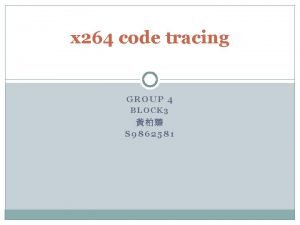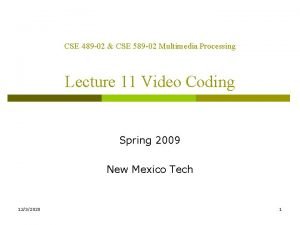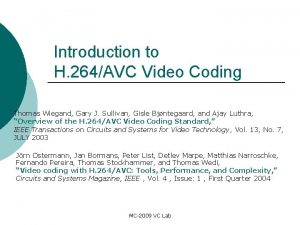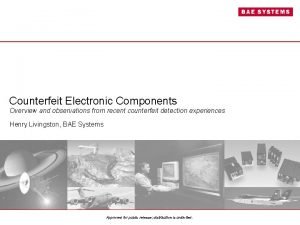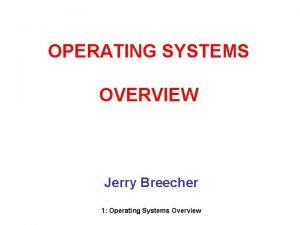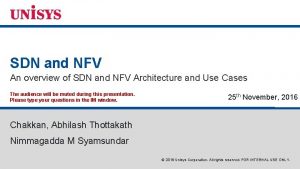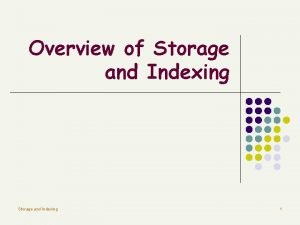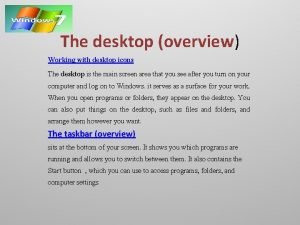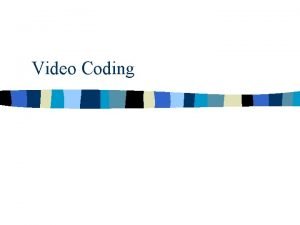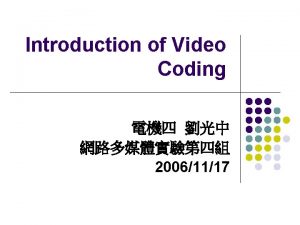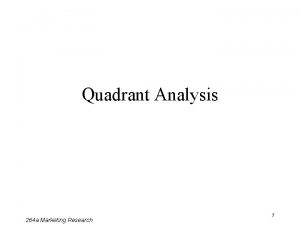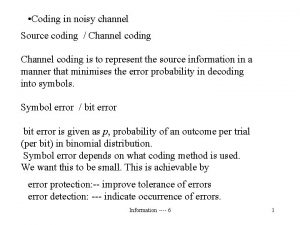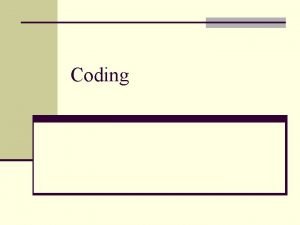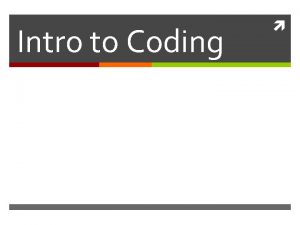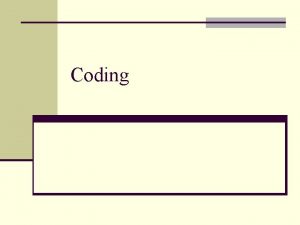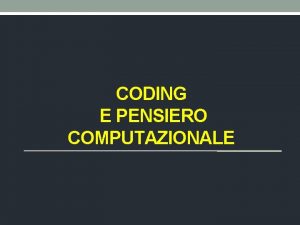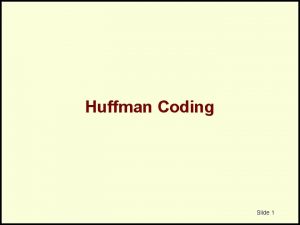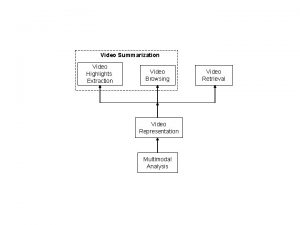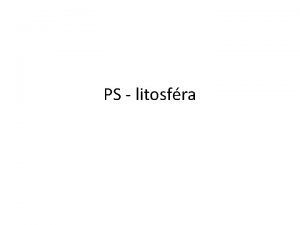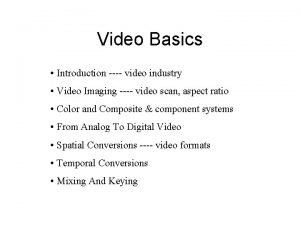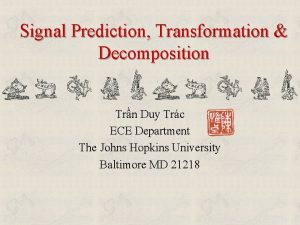Overview of H 264 Video Coding Trn Duy


















































- Slides: 50

Overview of H. 264 Video Coding Trần Duy Trác ECE Department The Johns Hopkins University Baltimore, MD 21218

Outline u Video coding standards § History § Generic framework u H. 264/ MPEG-4 AVC § § u u Main features Key technical innovations Coding performance Profiles: basic, main and high profiles Challenging problems Applications and markets

History of Video Standards

ITU H. 26 x History u u ITU H. 26 L: “long-term” solution for low bit-rate video coding for communication apps Predecessors include § H. 261 (1990): “px 64”, video conf. solution § H. 263 (1995): next conf. solution, used in H. 323 § H. 263+, H. 263++, follow-on solutions u u u H. 26 L project dates back to early ’ 90 s Call formal proposals in January 1998 First draft in August 1999 Joining forces with MPEG: Dec. 2001 H. 264 (H. 26 L) completed in May 2003

MPEG History u MPEG-1 (1993) § Video on CD (VCD) u MPEG-2 (1994) § DTV Broadcast, DVD, HD u MPEG-4 (1999 - ) § Cell phone, interactive, high rate communication § Object-oriented § Over-ambitious? u AVC (2003) § Conventional to HD § Emphasis on compression performance and loss resilience

Generic Framework* + DCT, Q _ Entropy Coding Bitstream Q-1, IDCT MC Next Frame Video in ME Prediction loop Buffer Previous frame * H. 261, 263+, MPEG-1/2/4

H. 264 Video Coding u u u Development history Main features Key compression techniques § Tools § Framework u u Performance Profiles § Basic and main profiles § High profile § Other new profiles

Development History u Dec 2001 – Start § Joint Video Team (JVT) formed between ITU/MPEG u u u u u Dec 2002 – Tech freeze May 2003 – ITU-T Rec. H. 264 June 2003 – ISO/IEC final draft (FDIS) July 2003 – Launch of FRExt (Fidelity Range) extension project Oct 2003 – ISO/IEC (14496 -10) AVC Dec 2003 – Verification tests by MPEG Jun 2004 – FRExt project is finalized Jan 2005 – Scalable Video Coding (SVC) project starts Jul 2006 – Multi-View Video Coding (MVC) project starts

Main Features u High compression performance § Advanced compression tools § Average 50% bit rate reduction given fixed fidelity compared to other standards u Exact match decoding § Integer transform u Improved perceptual quality § In-loop deblocking filter u Network friendliness § NAL (network abstraction layer) § Enhanced error resilience

H. 264 Technical Tools u Structure § Sequence ->GOP->Picture->Slice->MB->Block u u u Picture type: I, P, B, SI, SP Frame structure: interlaced, progressive Adaptive frame/field: per picture, per MB Deblocking filter – in loop MV resolution – ¼ pixel Tree-like motion segmentation – 16 x 16 to 4 x 4 Entropy coding – CAVLC/CABAC Data partition – NAL unit, priority ASO (arbitrary slice order) – independently decodable FMO (flexible macroblock order) – map ABP (adaptive bi-prediction) – adaptive weighting

Block Diagram: H. 264 Encoder Intra Prediction + DCT, Q _ Entropy Coding Bitstream Switch Q-1, IDCT MC Next Frame Video in ME Motion Compensation Loop Buffer Loop Filter Prediction loop +

Innovation 1: Transform Quantization step size control is nonlinear: step size increases gradually by about 12% (double after 6 steps)

16 bit 4 x 4 DCT u EXACT MATCH simplified transform § 4 x 4 transform § Non-orthonormality of the integer transform, i. e. , position dependent scaling § Requires only 16 bit arithmetic (including intermediate values) § Expanded to 8 x 8 for Chroma by 2 x 2 transform of the DC values

Quantization u Quantization of transform coefficients § § § Logarithmic step size control Extended range of step sizes Smaller step size for chroma 16 -bit multiply, add and shift Table-driven: 2 times in Qstep for every 6 th increment in Qp

Innovation 2: Intra Prediction § Directional spatial prediction (9 types for luma, 1 for 4 x 4 chroma) Q I J K L M N O P A a e i m B b f j n C c g k o D E F G H d h l p 0 7 2 8 4 6 1 5 3 • e. g. , Mode 3: diagonal down/right prediction a, f, k, p are predicted by (A + 2 Q + I + 2) >> 2

4 x 4 Intra Block Prediction Modes u Nine 4 x 4 block prediction modes

16 x 16 Luma (8 x 8 Chroma) Intra Prediction u Four 16 x 16 Luma (8 x 8 chrominance) intra predication modes

Innovation 3: Flexible Block MC 16 x 16 MB Types 0 8 x 8 Types 0 16 x 8 0 1 8 x 4 0 1 8 x 16 0 1 4 x 8 0 1 8 x 8 0 1 2 3 4 x 4 0 1 2 Motion vector accuracy 1/4 (6 -tap filter) (1/8 sample bilinear for Chroma) 3

Example: H. 264 MC

Innovation 4: Multiple Reference Frames 5 Ref frames New frame

Multiple Reference Frames u Reference blocks u Weighted bi-prediction

Innovation 5: In-Loop Deblocking

In-Loop Deblocking Filter u u u Improves subjective visual quality Much better than out-of-loop post-filtering Highly context adaptive Without loop filter With H. 264/AVC loop filter

Innovation 6: Two Entropy Coding Methods - CAVLC (Context-Adaptive Variable. Length Coding) - CABAC (Context-Adaptive Binary Arithmetic Coding)

H. 264 Entropy Coding u Exp-Golomb Code § For all symbols except transform coefficients § Variable length codes with a regular construction, e. g. , 0 -> 1; 1 -> 010; 2 -> 011; 3 -> 00100; 4 -> 00101; 5 -> 00110 6 -> 00111; 7 -> 0001000; 8 -> 0001001 … u CAVLC (Context adaptive VLC) § § u For transform coefficients No end-of-block, but the number of coefficients is encoded Coefficients are scanned backwards Contexts are built dependent on transform coefficients CABAC (Context-based binary arithmetic coding) § § For transform coefficients Uses adaptive probability models for most symbols Exploiting symbol correlations by using contexts Average bi-rate saving over CAVLC 10 -15%

Innovation 7: Network Abstraction Layer

H. 264 vs. MPEG-2: Low bit-rate (1)

H. 264 vs. MPEG-2: Low bit-rate (2) MPEG-2 203 kbps H. 264 39 kbps

Comparison to Other Standards

Basic H. 264 Profiles u Baseline (Video-conferencing & Wireless) § § § § u I and P frames (no B frame) Interlace Adaptive frame/field In-loop deblocking filter ¼ -sample motion compensation Variable block motion estimation CAVLC Some error resilience features, e. g. , ASO, FMO Main profile (Broadcast) § § § All baseline features except enhanced error resilience features B frame CABAC MB-level frame/field switching Adaptive weighting for B and P picture prediction

Enhanced H. 264 Profiles u Extended Profiles (Streaming) § Main profiles + Error resilience - CABAC § More error resilience: data partition § SP/SI switching pictures u High profile § § § Old name: Fidelity-Range Extensions (FRExt) Main profile Switchable 8 x 8 transform Scaling matrix for subjective quality optimization Implementation beyond Main Profile affects Intra prediction, transform, deblocking filter control, CABAC decoding

High Profile u H. 264/AVC standard finished 2003 § ITU-T/H. 264 finalized May, 2003 § MPEG-4 AVC finalized July, 2003 u High profile § § Initiated in July 2003 and finished in July 2004 Motivation: higher quality and higher rates Consider more than 8 bits sequences, and various color spaces Improved coding efficiency (bit-rate reduction): e. g. , 12% for HD films and progressive HD video § Complexity issues: § No increase in computational requirements § Slight increase in memory requirements (CABAC, transform) § No reason not to move to High profile !

New Features in High Profile u Larger transforms § 8 x 8 transform § Drop 4 x 8, 8 x 4, and larger transforms u Quantization matrix § 4 x 4, 8 x 8, intra, inter trans. coefficients weighted differently § Full capabilities not yet explored (visual weighting) u Coding in various space § 4: 4: 4, 4: 2: 2, 4: 2: 0, and monochrome § New integer color transform u u Efficient lossless interframe coding Film grain characterization for analysis/synthesis representation Stereo-view video support De-blocking filter display preference

8 x 8 16 -bit Transform u Computational complexity § One 8 x 8 block has the same number of adds (64) and 4 extra shifts (20 vs. 16) compared with four 4 x 4 transform

8 x 8 Transform Coefficients Scan u Two Scans § Different scan for frame/field coding Frame scan Field scan

8 x 8 Intra Block Prediction u Nine intra-prediction modes similar to the nine modes for 4 x 4 block prediction &

Quantization Matrix u u u u Similar concept to MPEG-2 design Vary step size based on frequency Adapted to modified transform structure More efficient representation of weights Separate matrix for inter and intra Matrix can be included in picture/slice head information Eight downloadable matrices (at least for 4: 2: 0) § § Intra 4 x 4 Y, Cb, Cr Intra 8 x 8 Y Inter 4 x 4 Y, Cb, Cr Inter 8 x 8 Y

Reversible Integer Color Transform u Color transform for YUV u Integer color transform (YCo. Cg)

Other High Profile Details u Deblocking filters: § Only control of filter is adjusted: do no filter for 4 x 4 blocks § Filter operation itself does not change u CABAC § 61 contexts and their corresponding initial values § No change to CABAC engine u Information signaling § 8 x 8 transform on/off flag at the picture head information § 8 x 8 transform on/off flag at per macroblock allows adaptive use

H. 264 High Profile vs. MPEG-2 Big. Ship HD sequence (1280 x 720, 720 p)

Subjective Performance * u Subjective tests by Blu-Ray Disk Founders of FRExt HP § 4: 2: 0/8 (HP) 1920 x 1080 x 24 p (1080 p), 3 clips. § Notional 3: 1 advantage to MPEG-2 § 8 Mbps HP scored better than 24 Mbps MPEG-2! § Apparent transparency at 16 Mbps! 5: Perfect 4: Good 3: Fair (OK for DVD) 2: Poor 1: Very Poor *JVT-L 033, M 1116, Draft JVT Redmond report

High Profile I-Frame Coding vs. JPEG 2000 u u High profile I frame coding with RD-optimization model selection RD-optimized JPEG 2000 coder used

Challenging Problems u Major problem: reduce the computational complexity without sacrificing the performance § Motion estimation § Fast motion search § Reference frames selection § Macroblock mode decisions § Seven inter modes, intra mode with prediction § Try all and select the best? § Mode decision criterion needed § Etc. u Implementation issues § Read time H. 264 encoding and decoding § Hardware implementations § Etc.

Applications and Markets u Storage § Video CD, DVD, Hard Disk, Web publishing u Broadcast § Satellite, Cable, Terrestrial u Conversational § Video-conferencing, Cell phones, PDAs u Streaming § Video-on-demand, music video, streaming ads u Future Applications! – unknown

H. 264 Opportunities Map Hardware-Based Codec Implementation MPEG-2, Open Standards Dominant WMT, Real Dominant Portable Gaming HD STB IP STB Software-Based Video Conferencing PVR/ Home. Net PC Streaming Mobile Videophony HD DVD Players Instant Video Messaging MCCD’s Mobile Streaming Still Cameras Security/Defense HD DVD Media Digital Cinema Annual Shipments

Example: HD DVD Multimedia u With H. 264, put 2 hours of HD on DVD-9 § Note: a 100 -min HD movie fits in 8. 25 GB @ 11 Mb/s u Keep MPEG-2 skin § Systems, audio… minor change to DVD player § Small cost, big quality jump u Even better with blue-ray when ready § Tech is “laser-agnostic” u Studios can recycle catalog in HD § Double the money!! Source: DVD-FAQ (Jim Taylor)

H. 264/AVC Organization Adoptions u u ITU-T systems adoption completed as early as May 2003 MPEG-2 and MPEG-4 systems & file format adoption HD DVD in DVD Forum: Mandatory player support Blue-Ray Disc Founders (BDF) § High Profile (HP) is their first choice beyond MPEG-2 u u u Digital Multimedia Broadcast in Rep. of Korea Mobile broadcast announcement in Japan France Terrestrial Broadcast announcement § H. 264/AVC HD instead of MPEG-2

Companies Publicly Known to Implement H. 264 Standard u u u u u u u u u Ahead Software / ATEME u Optibase Amphion u Packetvideo Apple Computer u Pixel. Tools British Telecom u Pix. Sil Technology Broadcom / Sand Video (chips) u Polycom (videoconferencing & MCUs) Conexant (chipset for STB) u Prodys Cradle u Radvision (videoconferencing) Deutsche Telekom u Richcore DG 2 L u Samsung (Terrestrial DMB receiver) Dicas u Scientific Atlanta DSP Research / W&W Communications u Setabox Emblaze Group u Sky. Stream Networks Envivio u Sony (encode & decode, software & hardware, including Play. Station Portable 2004 & videoconferencing systems) Equator u ST Micro (decoder chip in ‘ 03) Fast. VDO u Tandberg (shipping with all videoconferencing endpoints since July ’ 03, France Telecom GW and MCU since Oct. ) Hantro u Tandberg. TV Harmonic (filtering and motion estimation) u Tektronix HHI (PC & DSP encode & decode; demos) u Techno Mathematical i 3 Micro Technology u Telesuite i. Vast u thin multimedia Intel u Thomson KDDI R&D Labs u TI (DSP partner with UBV for one of two UBV real-time implementations) Ligos u Toshiba LSI Logic / Videolocus u Tuxia Mainconcept u UB Video (demoed real-time encode and decode, software and DSP Mcubeworks implementations) Media Excel u Videosoft / Vanguard Software Solutions (s/w, enc/dec) Mobile Video Imaging u Video. Tele. com (a division of Tut Systems) Mobilygen u VCON Modulus Video (main profile levels 3 & 4 b’cast encoders & professionalu Vqual use decoders) u W&W Communications / DSP Research Moonlight Cordless Motorola Neomagic CAUTION: This information should be considered preliminary and should not be Nokia Oki Electric considered to be product announcements – only preliminary implementation work. It may be a while before robust interoperable implementations are well-established.

References u u u u u IEEE Transactions on Circuits and Systems for Video Technology, July 2003. http: //www. vcodex. com/h 264. html ftp site: http: //bs. hhi. de/~suehring/tml/ P. Topiwala, H. 264/AVC: Overview and Introduction to Fidelity-Range Extensions, http: //www. fastvdo. com T. Wiegand, S. Gordon, A. Luthra: H. 264/AVC High Profile, Presented to DVB, Sept 2004 H. 264 Overview, Add. Pac Tech. Co. Ltd. JVT-L 033, M 1116, Draft JVT Redmond report G. Sullivan, P. Topiwala, and A. Luthra, The H. 264/AVC Advanced Video Coding Standard: Overview and Introduction to the Fidelity Range Extensions, SPIE Conference on Applications of Digital Image Processing XXVII, Special Session on Advances in the New Emerging Standard: H. 264/AVC, August, 2004 L. Liu, P. Topiwala, P. Rault and T. D. Tran, Comparison of JPEG 2000 with H. 264/AVC FRExt I - Frame Coding on 720 p Video Sequences, JVT-N 010, Jan. 2005 Google H. 264

What’s Next? H. 264+ or H. 265! u u u NGVC: Next-Generation Video Coding Goal: 50% bit-rate reduction, same complexity, same perceptual video quality Some new tools under investigation u u u Adaptive interpolation filter (AIF) for sub-pixel MEMC "Super-macroblock" structure up to 64 x 64 with additional transforms Adaptive prediction error coding (APEC) in spatial and frequency domain Adaptive quantization matrix selection (AQMS) Competition-based scheme for motion vector selection and coding Mode-dependent adaptive transform for intra coding
 Overview of the h.264/avc video coding standard
Overview of the h.264/avc video coding standard Contoh selective coding
Contoh selective coding Open coding
Open coding Trn krizovka
Trn krizovka Lutke racunaju
Lutke racunaju Trn verification
Trn verification Trn t
Trn t Bolezni kosti
Bolezni kosti Trn mt1
Trn mt1 Viêm đường mật cấp
Viêm đường mật cấp Morse code trn
Morse code trn Axial coding vs open coding
Axial coding vs open coding Coding dna and non coding dna
Coding dna and non coding dna Basit devre elemanlarının sembolleri
Basit devre elemanlarının sembolleri Tháp tư duy bloom
Tháp tư duy bloom Sơ đồ tư duy bài lượm
Sơ đồ tư duy bài lượm Ngủ đi mộng vẫn bình thường phạm duy
Ngủ đi mộng vẫn bình thường phạm duy Line of duy
Line of duy Hsg227
Hsg227 264 - 146
264 - 146 264 code
264 code 263 papa
263 papa H.264
H.264 5 x 264
5 x 264 Round 826 to the nearest ten
Round 826 to the nearest ten H.264
H.264 5 x 264
5 x 264 O'timli fe'llarga misollar
O'timli fe'llarga misollar Find the odd one : 396, 462, 572, 427, 671, 264
Find the odd one : 396, 462, 572, 427, 671, 264 H.264 profiles and levels
H.264 profiles and levels Hybrid video coding
Hybrid video coding Video.search.yahoo.com search video
Video.search.yahoo.com search video Searchyahoo
Searchyahoo Digital media primer
Digital media primer Video yandex ru
Video yandex ru Atm wan technology
Atm wan technology Pcb thieving
Pcb thieving Counterfeit electronic components an overview
Counterfeit electronic components an overview Psrc overview
Psrc overview Operating systems overview
Operating systems overview Sdn vs nfv
Sdn vs nfv Overview of financial management
Overview of financial management Fsma overview
Fsma overview Sql server mds
Sql server mds Overview of storage and indexing
Overview of storage and indexing Small pictures that represent files folders and programs
Small pictures that represent files folders and programs Vertical retailers
Vertical retailers Grid computing introduction
Grid computing introduction M commerce infrastructure
M commerce infrastructure Sdn vs traditional networking
Sdn vs traditional networking Sub service line ey
Sub service line ey
